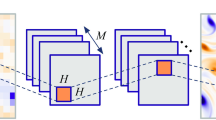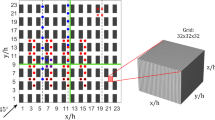Abstract
We demonstrate how application of the stochastic estimation method can be employed to combine spatially well-resolved wind-tunnel particle image velocimetry measurements with instantaneous velocity signals from a limited number of sensors (six sonic anemometers located within the canyon in the present case) to predict full-scale flow dynamics in an entire street-canyon cross-section. The investigated configuration corresponds to a street-canyon flow in a neutrally stratified atmospheric boundary layer with the oncoming flow being perpendicular to the main canyon axis. Data were obtained during both full-scale and 1:200-scale wind-tunnel experiments. The performance of the proposed method is investigated using both wind-tunnel data and signals from five sonic anemometers to predict the velocity from the sixth one. In particular, based on analysis of the influence of the high-frequency velocity fluctuations on the quality of the reconstruction, it is shown that stochastic estimation is able to correctly reproduce the large-scale temporal features of the flow with the present set-up. The full dataset is then used to spatially extrapolate the instantaneous flow measured by the six sonic anemometers and perform detailed analysis of instantaneous flow features. The main features of the flow, such as the presence of the shear layer that develops over the canyon and the intermittent ejection and penetration events across the canyon opening, are well predicted by stochastic estimation. In addition, thanks to the high spatial resolution made possible by the technique, the intermittency of the main vortical structure existing within the canyon is demonstrated, as well as its meandering motion in the canyon cross-section. It is also shown that the canyon flow, particularly its spanwise component, is affected by large-scale fluctuations of low temporal frequency along the canyon axis. Finally, the proposed techniques based on wind-tunnel data can prove useful for a priori design of field experiments to determine the optimum location of sensors beforehand.














Similar content being viewed by others
References
Adrian RJ (1975) On the role of conditional averages in turbulence theory. Turbulence in liquids. Science Press, Princeton, pp 323–332
Arnfield AJ, Mills GM (1994) An analysis of the circulation characteristics and energy budget of a dry, asymmetric, east-west urban canyon. II. Energy budget. Int J Climatol 14(3):239–261
Balogun A, Tomlin A, Wood C, Barlow J, Belcher S, Smalley R, Lingard J, Arnold S, Dobre A, Robins A, Martin D, Shallcross D (2010) In-street wind direction variability in the vicinity of a busy intersection in Central London. Boundary-Layer Meteorol 136(3):489–513
Belcher SE (2005) Mixing and transport in urban areas. Philos Trans R Soc A 363(1837):2947–2968
Blackman K, Perret L, Savory E (2015a) Effect of upstream flow regime on street canyon flow mean turbulence statistics. Environ Fluid Mech 15(4):823–849
Blackman K, Perret L, Savory E, Piquet T (2015b) Field and wind tunnel modeling of an idealized street canyon flow. Atmos Environ 106:139–153
Bonnet JP, Cole DR, Delville J, Glauser MN, Ukeiley LS (1994) Stochastic estimation and proper orthogonal decomposition: complementary techniques for identifying structure. Exp Fluids 17:307–314
Bonnet PJ, Delville J, Glauser NM, Antonia AR, Bisset KD, Cole RD, Fiedler EH, Garem HJ, Hilberg D, Jeong J, Kevlahan RNK, Ukeiley SL, Vincendeau E (1998) Collaborative testing of eddy structure identification methods in free turbulent shear flows. Exp Fluids 25(3):197–225
Cai XM (2011) Effects of wall heating on flow characteristics in a street canyon. Boundary-Layer Meteorol 142(3):443–467
Cui Z, Cai X, Baker CJ (2004) Large-eddy simulation of turbulent flow in a street canyon. Q J R Meteorol Soc 130(599):1373–1394
Dantec Dynamics A/S (2013) DynamicStudio v3.41 user’s guide
Dobre A, Arnold S, Smalley R, Boddy J, Barlow J, Tomlin A, Belcher S (2005) Flow field measurements in the proximity of an urban intersection in London, UK. Atmos Environ 39(26):4647–4657
ESDU (1982) Strong winds in the atmospheric boundary layer. Part I: Mean-hourly wind speeds. Data item 82026 (amended 1993). Eng Sci Data Unit Int
ESDU (1985) Characteristics of atmospheric turbulence near the ground. Part II: Single point data for strong winds (neutral atmosphere). Data item 852020 (amended 1993). Eng Sci Data Unit Int
Foken T, Göockede M, Mauder M, Mahrt L, Amiro B, Munger W (2005) Post-field data quality control. In: Handbook of micrometeorology: a guide for surface flux measurement and analysis. Springer, Dordrecht, pp 181–208
Guezennec YG (1989) Stochastic estimation of coherent structures in turbulent boundary layers. Phys Fluids 1:1054–1060
Guillaume G, Ayrault C, Brengier M, Calmet I, Gary V, Gaudin D, Gauvreau B, Lhermite P, Lihoreau B, Perret L, Picaut J, Piquet T, Rosant JM, Sini JF (2012) Micrometeorological effects on urban sound propagation: a numerical and experimental study. In: Rauch S, Morrison GM (eds) Urban environment, alliance for global sustainability book series, vol 19. Springer, Dordrecht, pp 109–119
Jimenez J (2004) Turbulent flows over rough walls. Annu Rev Fluid Mech 36:173–196
Kastner-Klein P, Berkowicz R, Britter R (2004) The influence of street architecture on flow and dispersion in street canyons. Meteorol Atmos Phys 87:121–131
Kellnerová R, Kukac̆ka L, Jurc̆áková K, Uruba V, Jan̆our Z (2012) PIV measurement of turbulent flow within a street canyon: detection of coherent motion. J Wind Eng Ind Aerodyn 104–106:302–313
Klein P, Clark JV (2007) Flow variability in a north american downtown street canyon. J Appl Meteorol Clim 46(6):851–877
Lee JH, Seena A, S-H L, Sung HJ (2012) Turbulent boundary layers over rod- and cube-roughened walls. J Turbul 13(40):1–26
Lee SH, Sung HJ (2007) Direct numerical simulation of the turbulent boundary layer over a rod-roughened wall. J Fluid Mech 584:125–146
Leonardi S, Orlandi P, Djenidi L, Antonia R (2004) Structure of turbulent channel flow with square bars on one wall. Int J Heat Fluid Flow 25(3):384–392
Li XX, Liu CH, Leung DY, Lam K (2006) Recent progress in CFD modelling of wind field and pollutant transport in street canyons. Atmos Environ 40(29):5640–5658
Li XX, Britter RE, Koh TY, Norford LK, Liu CH, Entekhabi D, Leung DYC (2010) Large-eddy simulation of flow and pollutant transport in urban street canyons with ground heating. Boundary-Layer Meteorol 137(2):187–204
Louka P, Belcher SE, Harrison RG (2000) Coupling between air flow in streets and the well-developed boundary layer aloft. Atmos Environ 34:2613–2621
Michioka T, Sato A (2012) Effect of incoming turbulent structure on pollutant removal from two-dimensional street canyon. Boundary-Layer Meteorol 145(3):469–484
Michioka T, Takimoto ASH, Kanda M (2010) Large-eddy simulation for the mechanism of pollutant removal from a two-dimensional street canyon. Boundary-Layer Meteorol 138:195–213
Michioka T, Takimoto H, Sato A (2014) Large-eddy simulation of pollutant removal from a three-dimensional street canyon. Boundary-Layer Meteorol 150(2):259–275
Monnier B, Neiswander B, Wark C (2010) Stereoscopic particle image velocimetry measurements in an urban-type boundary layer: Insight into flow regimes and incidence angle effect. Boundary-Layer Meteorol 135(2):243–268
Murray NE, Ukeiley LS (2007) Modified quadratic stochastic estimation of resonating subsonic cavity flow. J Turbul, pp 1–24. doi:10.1080/14685240701656121
Neophytou MKA, Markides CN, Fokaides PA (2014) An experimental study of the flow through and over two dimensional rectangular roughness elements: deductions for urban boundary layer parameterizations and exchange processes. Phys Fluids 26:1–21
Oke TR (1988) Street design and urban canopy layer climate. Energy Build 11:103–113
Perret L, Savory E (2013) Large-scale structures over a single street canyon immersed in an urban-type boundary layer. Boundary-Layer Meteorol 148:111–131
Pey YY, Chua LP, Siauw WL (2012) Stochastic estimation of cavity flow field. Int Sch Sci Res Innov 6(11):754–759
Rivet C (2014) étude en soufflerie atmopshèrique des interactions entre canopée urbaine et basse atmosphère par PIV stéréoscopique. PhD thesis, Centrale Nantes
Salizzoni P, Marro M, Soulhac L, Grosjean N, Perkins RJ (2011) Turbulent transfer between street canyons and the overlying atmospheric boundary layer. Boundary-Layer Meteorol 141:393–414
Snyder HW, Castro PI (2002) The critical reynolds number for rough-wall boundary layers. J Wind Eng Ind Aerodyn 90:41–54
Takimoto H, Sato A, Barlow JF, Moriwaki R, Inagaki A, Kanda SOM (2011) Particle image velocimetry measurements of turbulent flow within outdoor and indoor urban scale models and flushing motions in urban canopy layers. Boundary-Layer Meteorol 140:295–314
Walton A, Cheng A (2002) Large-eddy simulation of pollution dispersion in an urban street canyonpart ii: idealised canyon simulation. Atmos Environ 36(22):3615–3627
Zhu W, van Hout R, Luznik L, Kang HS (2006) A comparison of PIV measurements of canopy turbulence performed in the field and in a wind tunnel model. Exp Fluids 41:309–318
Acknowledgments
The authors would like to thank Mr. Thibaut Piquet for technical support during the experimental program and both the Region de Pays de La Loire (Research Program EM2PAU, Influence des effets micro-météorologiques sur la propagation acoustique en milieu urbain) and the Ontario Graduate Scholarship Program for providing funding. The first author also acknowledges financial support from the French National Research Agency through research grant URBANTURB no. ANR-14-CE22-0012-01.
Author information
Authors and Affiliations
Corresponding author
Rights and permissions
About this article
Cite this article
Perret, L., Blackman, K. & Savory, E. Combining Wind-Tunnel and Field Measurements of Street-Canyon Flow via Stochastic Estimation. Boundary-Layer Meteorol 161, 491–517 (2016). https://doi.org/10.1007/s10546-016-0179-0
Received:
Accepted:
Published:
Issue Date:
DOI: https://doi.org/10.1007/s10546-016-0179-0




